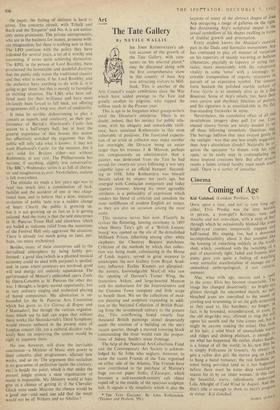Art
The Tate Gallery
By NEVILE WALLIS
This is apt to be forgotten when gossip-writers extol the Director's enterprise. There is no doubt, indeed, that his instinct for public rela- tions, with his ubiquity and remarkable resili- ence, have sustained Rothenstein in this most vulnerable of positions. The frustrated expecta- tion of an artist or collector may make another foe overnight, the Director being an easier target than his trustees. J. B. Manson, perhaps less conspicuously an administrator than a painter, was dethroned from the Tate he had served for twenty-six years following a not very culpable lapse at an official banquet. Succeed- ing in 1938, John Rothenstein was himself fiercely raked by snipers ten years ago, but emerged with Confucian composure and today appears immune. Among his more agreeable attributes is a perlucidity of expression which renders his blend of criticism and anecdote the most mellifluous of modern English art essays, as they are also on occasion among the most acute.
This resource serves him now. Fluently he revives the fluttering, bowing ceremony in 1897 when Henry Tate's gift of a 'British Luxem- bourg' was opened on the site of the demolished Millbank Prison, inheriting among other white elephants the Chantrey Bequest purchases. Criticism of the methods by which that collec- tion was being made, culminating in the House of Lords inquiry, served in great measure to emancipate the new Gallery from Royal Acad- emy influence. Earlier Keepers are glimpsed.: the austere, knowledgeable MacColl who saw the opening of Duveen's Turner Wing, the featureless Aitken, and large-hearted Manson with his enthusiasm for the Impressionists and the Camden Town company and little scope to benefit them. We see the collections of mod-
ern painting and sculpture expanding in addi- tion to the National Collection of British Paint- ing from the seventeenth century to the present day. This overflowing hoard (nearly four thousand British paintings alone) desperately
needs the erection of a building on the site's vacant quarter, though a mooted towering block commanding the river would ruin the propor- tions of Sidney Smith's stone frontage.
The help of the National Art-Collections. Fund and the Contemporary Art Society is acknow- ledged by Sir John who neglects, however, to name the recent Friends of the Tate organised on either side of the Atlantic. The Friends have
now contributed to the purchase of. Matisse's huge cut-out paper frolic, L'Escargot, which becomes a mid-twentieth-century cult object roped off in the middle of the spacious sculpture hall. It signals a sly simplicity which is also the • THE TATE GALLERY. By John Rothenstein. (Thames and Hudson, 35s.) keynote of many of the abstract shapes of Jean Arp occupying a range of galleries on the right. But dominating Arp's sculptural output is the sexual symbolism of his shapes swelling in forms of fruitful growth and procreation. Every student knows the Alsatian's essential part in the Dada and Surrealist movements. Arp has continued to play all manner of variations on his repertory of mainly wavering or bulbous silhouettes; playfully in tapestry or string fan- tasies, more memorably with his voluptuous vitality in some `torso' with a seemingly in- evitable transposition of organic structures in pursuit of an expressive symbol. The sinuous form beneath the polished marble surface of Torse Gerbe is as intensely alive as in a fine Brancusi. Some of Arp's reliefs, too, have their own cursive and rhythmic felicities of pattern, and his signature is as unmistakable in the flat, free-standing fretworks in stone. Nevertheless, the cumulative effect of all this invertebrate imagery does pall for me. Con- trasted sinewy forms are surely needed to set off these billowing inventions. Questions ring- The barrage balloon that once swayed gentlY In the sunlight—was that any less amply suggestive than Arp's aluminium clouds? Naturally he re- quires the spectator 'to dream with his *TS open,' as he easily may in contemplating the more inspired creations here. But after several rooms a latent critical faculty must needs
itself. There is a surfeit of amoebae.






































 Previous page
Previous page